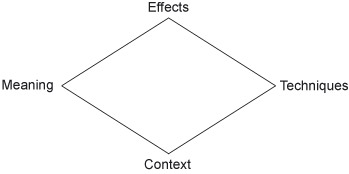4 The study diamond
I now introduce an approach that is useful for analysing and interpreting written texts (like poems) as well as the visual images we move on to next week. This is the study diamond (see Figure 2). Using the study diamond will help you strike a good balance between, on the one hand dismissing your own views too readily as ‘unworthy’, and, on the other hand, concentrating on them too much as the ‘only’ reading.
When used methodically, it provides a reliable and reusable formula for arriving at well-argued conclusions when interpreting a particular work.
There are four points to the study diamond:
An excellent way of learning how to apply the study diamond is to first simply try it out.
Activity 6 Applying the study diamond
The study diamond is a four-step approach. Try to apply it to the next sonnet in the following way:
- What effects does the poem have on you? What does it make you feel or think about?
- Which techniques are used by the poet? In this case, think about any rhyme and any imagery used.
- Are there any aspects about the context that need to be considered? This could include who wrote the poem, where it was written, when and under what circumstances, as well as your relationship with its context (bearing in mind that you have been given hardly any contextual information at this stage).
- Ask yourself about the meaning of the poem – what you think the poem is about, and whether it might be trying to convey any messages.
Read Elizabeth Barrett Browning’s ‘Sonnets from the Portuguese XLIII’ (published 1850) two or three times and make notes for each of the concepts.
Sonnets from the Portuguese XLIII
How do I love thee? Let me count the ways.
I love thee to the depth and breadth and height
My soul can reach, when feeling out of sight
For the ends of Being and ideal Grace.
I love thee to the level of everyday’s
Most quiet need, by sun and candlelight.
I love thee freely, as men strive for Right;
I love thee purely, as they turn from Praise.
I love thee with the passion put to use
In my old griefs, and with my childhood’s faith.
I love thee with a love I seemed to lose
With my lost saints, – I love thee with the breath,
Smiles, tears, all of my life! – and if God choose,
I shall but love thee better after death.
Comment
There are a number of valid responses to most of the questions posed by the study diamond, but hopefully you recognised first of all that the poem is about the speaker’s total love for ‘someone’. As the previous extract about the development of the sonnet suggests, this is one of the main themes commonly found in this form of poetry. The poem also conforms to one of the most common rhyme schemes: the Petrarchan (abbaabba cdcdcd). In these respects, then, it can be described as a conventional sonnet. You may have noted it differs in rhyme scheme from Shakespeare's Sonnet 18. There are some lines of iambic pentameter (ten syllables): the final line, for example, seems to be regular in this respect. Lines 3 and 6, too, read as pure iambic pentameter, and you may have spotted others.
There will be some further explanation of what is meant by ‘effect’, ‘techniques’, ‘context’ or ‘meaning’ in the next section.
The analysis also does not stop here. Once you have thought about these four aspects of the poem and made some notes, think about each aspect again. By repeating these stages, your analysis of the poem can continue to build, until you think you have enough information about all four points of the study diamond.
Note that you might not always want to start with the ‘effects’ point. Sometimes, for example, a potential meaning might be more obvious. In such cases, make a note of this, and then go on to consider the other three points of the diamond. Also, having applied the study diamond once to a text, you may then want to look at the points again in a different order. However, as a general rule, start by noting the effects of a text, and see where this leads you.
The four points of the study diamond each represent specific tasks, which together form a useful approach when interpreting a work of literature or art. Next you’ll look at each of these in turn.

